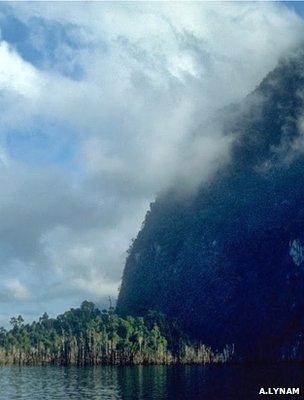Forest fragmentation triggers 'ecological Armageddon'
-
Published

Species affected by rainforest fragmentation are likely to be wiped out more quickly than previously thought, scientists have warned.
A study found that some small mammal species on forest islands, created by a hydroelectric reservoir, in Thailand became extinct in just five years.
It also showed that populations in the fragmented habitats were also at risk from another threat - invasive species.
The findings have been published in the journal Science.
Results showed that almost all small mammals disappeared from patches of fragmented forest smaller than 10 hectares (25 acres) within just five years, and larger plots - measuring up to 56ha - recorded the loss of small animals within 25 years.
Co-author Luke Gibson from the National University of Singapore said the team was very surprised by the findings, describing it "like an ecological Armageddon".
"None of us expected such a dramatic change from 20 years ago," he told the BBC's Science in Action programme.
"Our study focused on small mammals but what we did not report was a similar near-complete extinction of medium to large-sized mammals, such as elephants, tigers and tapirs, which are now completely absent from these islands in the reservoir.
"All of these animals were all in the forest landscape before the creation of the reservoir."
'Natural laboratory'
The researchers carried out their studies at the Chiew Lan (or Larn) Reservoir in southern Thailand. About 160 sq km of the Khao Sok National Park was flooded in the mid-1980s to create the reservoir.
The rising water also created in excess of 100 islands of tropical forest, which the team called a "natural laboratory".
The researchers carried out a survey of small mammals found on 16 of the islands, which ranged in size from 0.3ha to 56.3ha, five to seven years after the reservoir was created. They then repeated the survey 25-26 years after the islands were formed.
Co-author Prof William Laurance, one of the world's leading ecologists on habitat fragmentation, said there were probably two factors that drove the rapid demise of small mammals on the isolated habitats.
"Native mammals suffered the harmful effects of population isolation, and they also had to deal with a devastating invader - the Malayan field rat," he said.
The team found the population of the invading rat species became so abundant in just a few years that it displaced the native small mammals.
The field rat is known to invade disturbed habitats, such as fragmented forests.
Habitat fragmentation is widely recognised as one of the main global threats to biodiversity. Although it can occur naturally as a result of natural disasters, the main threat today comes via human activities, such as urbanisation and pressure for agricultural land.
Mr Gibson said he expected the trend of fragmentation in tropical landscapes to become increasingly common in the coming decades.
"One example [of a] highly fragmented forest region is in the Atlantic Forest of Brazil where more than 80% of fragments are smaller than 50ha in area," he observed.
"The bottom line is that we must conserve large, intact habitats for nature. That is the only way we can ensure biodiversity will survive."
-
-
Published13 July 2012
-
-
-
Published6 February 2007
-
-
-
Published10 January 2012
-